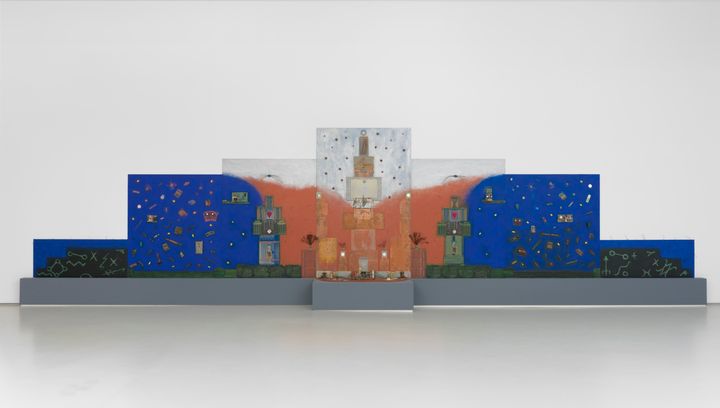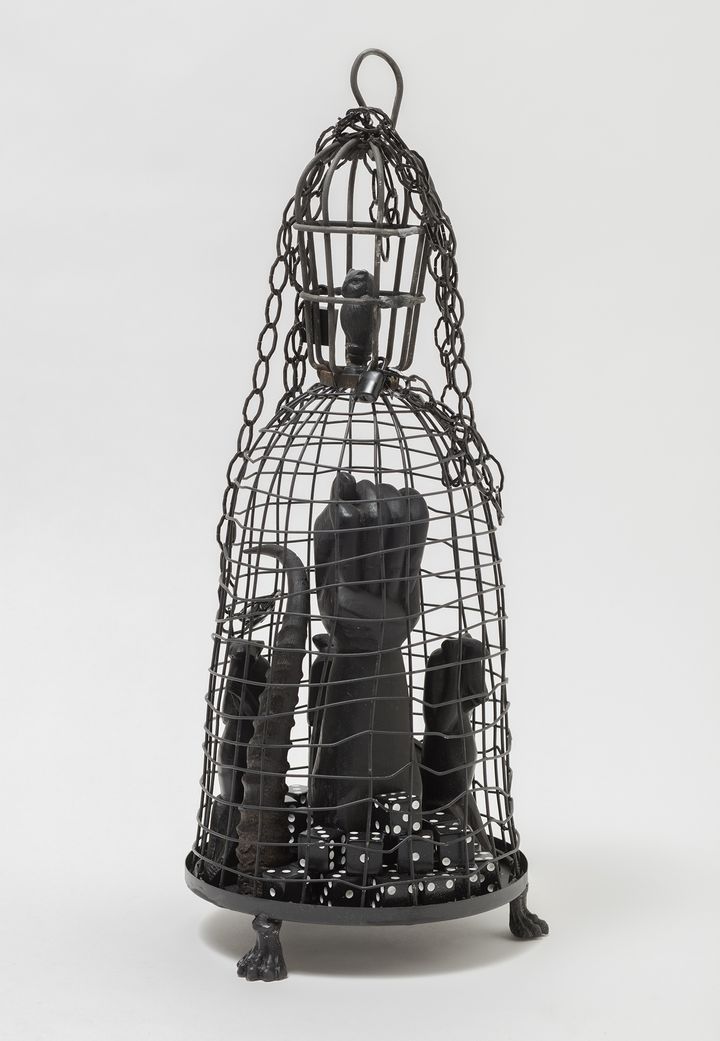
Betye Saar is a living legend, with a career that spans almost seven decades. She is one of the most celebrated exponents of assemblage art and a pioneer of both politicized African - American art and feminist art. Today, in her 90s, her work is still cutting-edge because she always captures the élan of the times - by exploring current racial and feminist issues in a powerful lexicon, that gives her work a sense of urgency.
Heritage women artists who use hands-on techniques and feminist artists who explore the cultural construction of gender have taken the center stage in Los Angeles this year. Hauser Wirth & Schimmel’s impressive inaugural exhibition, Revolution in the Making: Abstract Sculpture by Women 1947-2016, was followed by a solo exhibition of Maria Lassnig. An historical group feminist show at Spruth Magers, Eau de Cologne, was followed by a solo show of Hanne Darboven. The Broad recently had a major survey of Cindy Sherman’s work and Los Angeles County Museum of Art had a major show of Agnes Martin. So it is fitting to end this year of celebrating heritage women artists with Saar - a much loved L.A icon who has even received honorary doctorates - in a survey at Roberts & Tilton. This two-part exhibition of twenty-eight mixed media works from 1966-2016 coincided with Betye Saar: Ritual at Art Basel Miami Beach.

Before the election, I wrote a series of articles on the trending of feminist artists and heritage women artists as a reflection of both the increasing power of women in all areas of life and the emergence of a new brand of cross-generational feminism. The shock of an unpredictable election result and widespread sadness over the re-emergence of Jurassic white male supremacy now makes it impossible to predict the future of feminism or women artists or artists of color. Interestingly, sadness has always been an undercurrent in Saar’s evocative assemblages, which relate current injustice to past injustices - making her work particularly poignant, today.

Saar is obviously influenced by Joseph Cornell’s assemblage work , which she first saw in 1967 at Pasadena Museum. But her interest in making art from recycling things began much earlier when she first saw Simon Rodia’s Watt’s Tower, while visiting her grandmother’s neighborhood when she was a child. Saar also watched her mother making gifts, from things she could find. The idea that an artist could make art from everyday things found around them, developed very organically from these childhood experiences long before Saar became interested in Cornell’s assemblages because he worked in a way that felt natural to her.
After Saar graduated from studying design at UCLA ( 1947-9) she worked as an interior designer but her interiors for her family and friends became more like installations. Her artwork became more political after Martin Luther King’s assassination in 1968 and she became part of the Black Arts movement in the 1970s, challenging derogatory racial stereotypes and narratives. She began re-contextualizing discarded things she loves for the strong memories they evoke - and found a poetic visual language for her political concerns. Through this beautiful alchemy she transforms her rage at racial injustice into heart-felt art, made from everyday things that resonate with her - much as she remembered her mother making gifts. Saar’s artwork also has the wonderful quality of a gift because she pours her strong emotions into crafting it. Interestingly, Saar never sells artworks she makes using family memorabilia although they are often exhibited.

The survey at Roberts & Tilton is divided into two chapters that opened on staggered dates. Black White, is comprised of mixed media works exploring the socio-political connotations of blackness and whiteness. Blend, is comprised of mixed media works that use the more ambiguous connotations of grey ( in platforms and plinths) for less specific racial beliefs that underlie prejudice. The walls are painted black, white and grey as a background that reinforces color- coded belief systems. Each work explores different ways that color pervades our ideas of good and bad: from white magic to dark magic, from white knights to dark demons, from white light to dark moods. Tribal symbols are juxtaposed with discarded electrical debris to suggest intersections of ancient magic and technological magic.
Saar’s familiar leitmotifs recur throughout this fifty year survey: birdcages ( symbolizing incarceration) scales (symbolizing the injustice of unpunished murders of African American men) and ships (symbolizing the slave trade.) She also uses dolls, domestic utensils and hair to reference femininity and cigarette cases and pipes to reference masculinity. Saar enjoys finding objects in second- hand stores because they are vehicles for the “ghost” of their previous owners.

Over the decades Saar has developed a distinctive lexicon which she mines as an inexhaustible resource for creating visual meaning. Dark Journey: The Game of Destiny (2016) uses her characteristic birdcage motif perched on a vintage world globe map to relate the current racial injustice of incarceration of African American men, to early forms of segregation. Her birdcage and ship motifs are also used in The Destiny of Latitude and Longitude (2010) to explore different dimensions of captivity (from social to spiritual) with the suspension of one ship hanging from a moon over another ship on a sea of waves made from long grey hair.

The current interest in heritage women artists who make hands-on artwork could also be seen as a reflection of a widespread counter-cultural trend of returning to hand-crafted things : from coffee, ice cream, bread, pizza, beer, to re-purposed furniture which bring back the human touch which is missing in a commercial era. As people grow tired of an impersonal, soulless world of factory-made things and mass technology the human touch is being re-introduced.
After decades of factory-made artworks by artists who have moved outside the traditional art- making process to produce, what Gary Lloyd calls, “hands-off art” there is a growing counter- trend that values “hands-on art” which communicates the artist’s consciousness. Of course, monumental and labor-intensive artworks by Robert Irwin, Anselm Kiefer, Richard Jackson, Peter Shelton, Joan Jonas, Lita Alburquerque and Mary Corse require large crews but unlike more commercial artists like Jeff Koons, working at that scale, these artists are still always present inside their work, physically supervising every single detail. The presence of the artist inside the making of the work - whether it is hand-made in solitude or made by an artist working alongside a large crew - supports authenticity. Without the consciousness of the artist inside the artwork it rings hollow, because, as Susan Sontag says, “art is a form of consciousness.”
Saar is a living legend artist because she is always so far ahead of her time with meticulously hand- crafted artworks (in an era weary of mass production) which evoke the urgency of racial issues and feminist issues now ( in a Trump-era of rising white male supremacy.) The emotional relevance that established her reputation decades ago is as alive today as it was yesterday - and will be tomorrow.

In 2016, the year for heritage women artists, Saar has taken center stage with an unprecedented number of major museum exhibitions: at Fondazione Prada, Milan, Smithsonian National Museum of African American History & Culture, Washington, Whitney Museum of American Art, New York, Museum of Modern Art, New York, The Studio Museum of Harlem, New York, and a traveling museum exhibition at Museum de Domijen, Sittard and Scottsdale Museum of Contemporary Art, Arizona. In 2017 Saar has an upcoming solo exhibition at Craft & Art Museum, Los Angeles. She is also included in upcoming group exhibitions at Brooklyn Museum, New York and Tate Modern, London. Clearly, this living legend who comes from a family tradition of humble gift-making, has made a stupendous cultural contribution.
Where: Roberts & Tilton . 5801 Washington Blvd, Culver City, CA 90232 Tel: 323 549 0223
When: September 15 - December 17, 2016
